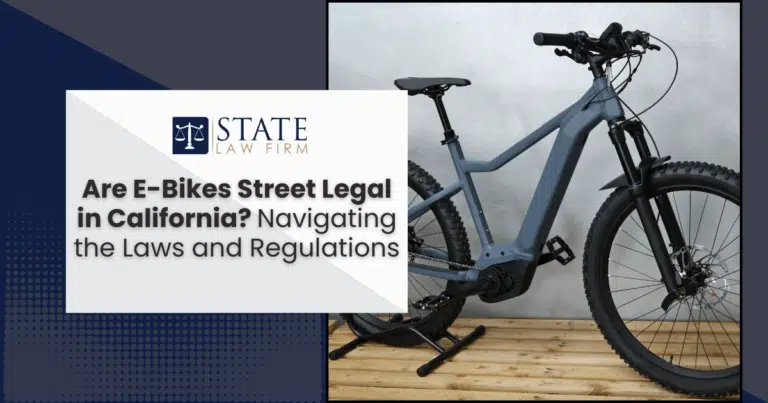Electric bicycles, or e-bikes, have revolutionized transportation in California, offering a sustainable and efficient way to get around. With their growing popularity, sales of e-bikes in the U.S. surged to over 1.1 million units in 2022, reflecting a 50% increase from the previous year. (Source). However, as e-bikes flood the streets, trails, and bike lanes, questions about their legality and regulations have become increasingly important for riders and property owners alike.
In California, e-bikes fall into a unique legal category with rules that vary depending on their classification, where you ride them, and even your city’s local ordinances. Understanding these regulations is essential—not only for safety but also to avoid potential legal issues.
At State Law Firm, based in Sherman Oaks, we understand how confusing these laws can seem, especially when it comes to navigating liability after an e-bike accident. As dedicated premises liability and personal injury lawyers, we strive to provide clarity and support for our clients in complex legal matters. Learn more about our premises liability services here.
This guide will help you explore the ins and outs of e-bike laws in California, from understanding e-bike classifications to learning about local ordinances and safety tips. Whether you’re an experienced rider or considering your first electric bicycle, we’ll navigate these laws together so you can enjoy your ride with peace of mind.
Understanding E-Bikes: What Defines an Electric Bicycle?
Electric bicycles, or e-bikes, are more than just a trendy way to get around—they represent a shift in how we approach urban transportation. An e-bike is defined as a bicycle equipped with an electric motor that assists the rider while pedaling or provides full throttle-powered movement. However, not all e-bikes are created equal.
There are two primary types of e-bikes:
- Pedal-Assist Bicycles: These require riders to pedal for the motor to engage, providing a boost to make hills and long commutes easier.
- Throttle-Controlled E-Bikes: These allow riders to engage the motor without pedaling, operating more like a moped in some cases.
California law further breaks down e-bikes into three classes based on their speed and motor capabilities, which directly influence where and how you can ride them. By understanding these classifications, riders can stay compliant and avoid fines or liability issues.
The Three Classes of E-Bikes and Their Legal Implications
California’s e-bike laws follow a three-class system, as outlined by CalBike. This classification determines the type of bike you own, where you can ride, and whether specific safety measures are required:
- Class 1 E-Bike: Pedal-assist only, with a motor that stops assisting at 20 mph. Legal for bike paths and most public spaces.
- Class 2 E-Bike: Equipped with a throttle and a motor that ceases assistance at 20 mph. Restricted from some bike paths.
- Class 3 E-Bike: Pedal-assist only but with a motor that stops assisting at 28 mph. Riders must be 16 or older and wear helmets. These are often restricted to roadways or bike lanes adjacent to roads.
Pro Tip: When purchasing an e-bike, ensure it has a clearly marked classification sticker to avoid confusion and potential fines. If you’re involved in an accident with an improperly classified e-bike, legal liability can become complicated. Our team is here to help you navigate those complexities.
E-Bike Laws in California: Key Regulations You Need to Know
California has specific rules for e-bike riders to ensure safety and compliance. These laws, set by the California Vehicle Code, include:
- Age Restrictions: Riders of Class 3 e-bikes must be at least 16 years old.
- Helmet Requirements: Helmets are mandatory for Class 3 riders and all riders under 18.
- Where to Ride: E-bikes are permitted on streets and designated bike lanes. However, bike path access depends on the e-bike’s class.
- Speed Limits: Riders must adhere to posted speed limits, especially in areas shared with pedestrians.
Pro Tip: Always check local regulations before riding in new areas. Non-compliance can lead to fines or liability in accidents. If you’re unsure about your rights after an incident, State Law Firm’s premises liability attorneys can provide clarity and support.
Local Ordinances: How City Rules May Affect E-Bike Usage
While California law provides a framework for e-bike regulations, local ordinances often add another layer of complexity. Cities like San Francisco and Los Angeles may impose stricter rules, particularly regarding bike lane access or the use of e-bikes in shared spaces. For instance:
- San Francisco: Recent concerns over lithium-ion battery fires have prompted stricter regulations for mobility devices, including e-bikes. (Source).
- Los Angeles: Local laws dictate where e-bikes can be ridden on trails and paths, often banning them from shared pedestrian zones.
Pro Tip: Research city-specific rules before planning your route. Whether you’re commuting or riding recreationally, understanding these laws can prevent unexpected citations or liability in accidents.
E-Bike Safety Requirements and Best Practices for Riders
Riding an e-bike safely requires more than just following the law. Adhering to safety best practices can protect you and others on the road:
- Essential Safety Gear:
- DOT-approved helmets
- Reflective clothing for night riding
- Front and rear lights
- Battery Safety: Avoid overcharging and inspect for damage regularly to prevent fires.
- Regular Maintenance: Check brakes, tires, and the motor system frequently to ensure peak performance.
Pro Tip: Investing in high-quality safety gear can not only protect you but also enhance your legal position in the event of an accident. If you’re injured due to faulty equipment or unsafe conditions, our team can help you seek compensation.
The Future of E-Bike Legislation in California: Trends and What to Expect
As e-bikes continue to grow in popularity, California is poised for significant legislative updates. Current trends suggest:
- Advocacy for More Bike Lanes: Groups like CalBike are pushing for expanded infrastructure to accommodate the rise in e-bike usage.
- Increased Regulation of Batteries: Addressing fire hazards from lithium-ion batteries is likely to become a legislative priority.
- Nationwide Trends Impacting California: States across the U.S. are redefining bike laws, which could influence California’s future policies.
Pro Tip: Staying informed about upcoming legislation can help you avoid compliance issues and ride confidently. For e-bike riders involved in accidents, understanding how these changes affect liability is crucial. Our attorneys can help you stay ahead of the curve.
Electric bicycles are changing the way we move, but navigating their legal landscape requires careful attention to detail. If you’ve been injured in an e-bike accident or have questions about liability, State Law Firm is here to guide you every step of the way. Let’s ensure you’re protected—on the road and in the courtroom.


